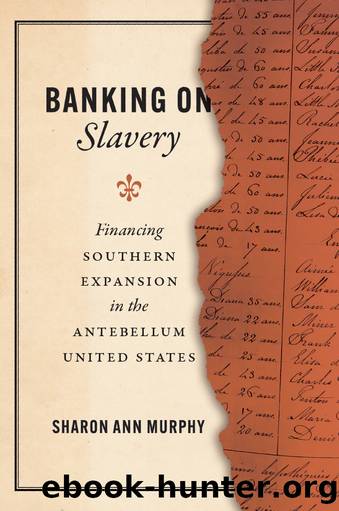Banking on Slavery by Sharon Ann Murphy

Author:Sharon Ann Murphy [Murphy, Sharon Ann]
Language: eng
Format: epub
Tags: HIS000000 HISTORY / General, HIS036050 HISTORY / United States / Civil War Period (1850-1877), BUS023000 BUSINESS & ECONOMICS / Economic History, HIS056000 HISTORY / African American & Black
Publisher: University of Chicago Press
Published: 2023-04-05T00:00:00+00:00
Outwitting Creditors through Fraudulent Conveyances
While debtor insolvency was a major problem for banks, especially after the panics, instances of fraud likewise increased substantially. For an insolvent debtor, successfully evading creditors through fraud was often preferable to starting over after declaring bankruptcy. Court dockets of the 1840s and even 1850s were thus filled with fraud cases stemming from the depression. For example, in the spring of 1837, Richard Abbey found himself deeply in debt to the Agricultural Bank of Mississippi.75 The New York State native migrated to Natchez as a teen, where he became a clerk in the dry-goods store of P. F. Merrick & Co. After a few years, âby reason of his great diligence and excellent business capacity, he rose to the headship of the establishment.â76 He subsequently married and became a leader in the Natchez community. He was an active member of the local Methodist church and of the Anti-Gambling Society, and âhe helped organize the first temperance society in the Southwest.â77 In May of 1833, he was elected a director of the newly formed Natchez Shipping Company, and appointed the companyâs secretary.78
Abbey bought out his partner just a month before Merrickâs unexpected death in May 1833, at the age of thirty-six. Abbey immediately began operating a new partnership called R. Abbey & Co. out of the same address âon Main Street, directly opposite the United States Bank.â79 The firm became the local agency of the Aetna Insurance Company in September 1833, and then a few months later, took on the agency of the American Hydraulic Company of Windsor, Vermont, which made fire engines.80 But the partnersâ main focus was dry goods, especially âLadies Misses and childrensâ clothing, boots, and shoes.81 The firm also occasionally dabbled in other items that came its way, from small lots of printing paper and âfresh garden seed,â to âCarpeting of excellent quality and the latest and most tasty patternsâ and âA First Rate Hartford-made Baroucheââa large, horse-drawn âfour-wheeled carriage with a driverâs seat high in front, two double seats inside facing each other, and a folding top over the back seat.â82
In December of 1833, R. Abbey & Co. also listed for sale a cotton plantation known as the Boston plantation, âsituated on the Yazoo river 8 miles above Manchester,â complete with âa good gin, convenient cabins, a good supply of plantation stock and utensils, and Sixteen Negroes, all first rate hands, between the ages of 11 and 40 years.â83 The Boston plantation had jointly belonged to his former partner Phineas Merrick and Hubbard Emerson, both natives of Massachusetts.84 Perhaps Merrick had sold out the dry-goods firm to Abbey in 1833 to become a full-time cotton planter before his sudden death; Hubbard was an absentee owner, only returning to Mississippi each winter to check on his business interests.85 After Merrickâs death, his widow (her hands already full with several small children) desired to sell the plantation, with Hubbardâs consent.86 Abbey apparently purchased it for himself, âfor between eighteen and nineteen thousand dollars.â87 By
Download
This site does not store any files on its server. We only index and link to content provided by other sites. Please contact the content providers to delete copyright contents if any and email us, we'll remove relevant links or contents immediately.
International Integration of the Brazilian Economy by Elias C. Grivoyannis(91654)
The Radium Girls by Kate Moore(11930)
Turbulence by E. J. Noyes(7942)
Nudge - Improving Decisions about Health, Wealth, and Happiness by Thaler Sunstein(7622)
The Black Swan by Nassim Nicholas Taleb(7016)
Rich Dad Poor Dad by Robert T. Kiyosaki(6413)
Pioneering Portfolio Management by David F. Swensen(6229)
Man-made Catastrophes and Risk Information Concealment by Dmitry Chernov & Didier Sornette(5925)
Zero to One by Peter Thiel(5691)
Secrecy World by Jake Bernstein(4652)
Millionaire: The Philanderer, Gambler, and Duelist Who Invented Modern Finance by Janet Gleeson(4385)
The Age of Surveillance Capitalism by Shoshana Zuboff(4216)
Skin in the Game by Nassim Nicholas Taleb(4165)
Bullshit Jobs by David Graeber(4101)
The Money Culture by Michael Lewis(4082)
Skin in the Game: Hidden Asymmetries in Daily Life by Nassim Nicholas Taleb(3935)
The Dhandho Investor by Mohnish Pabrai(3705)
The Wisdom of Finance by Mihir Desai(3658)
Blockchain Basics by Daniel Drescher(3511)
